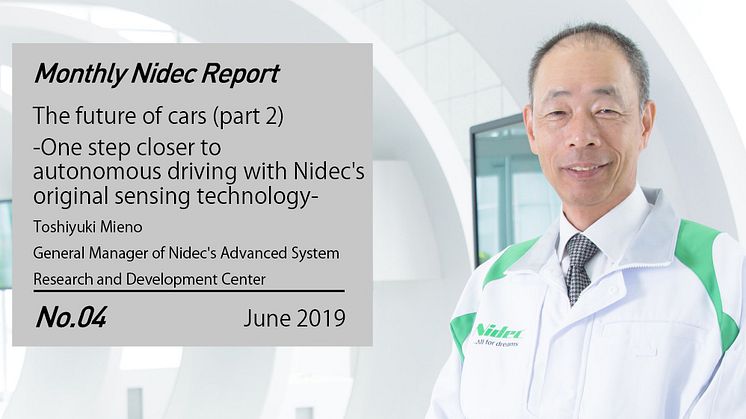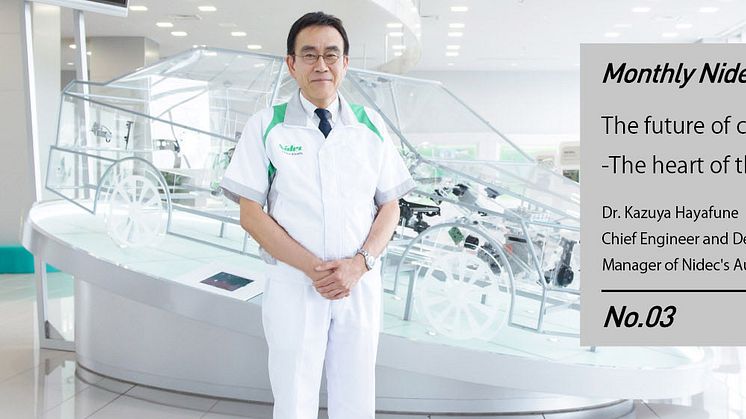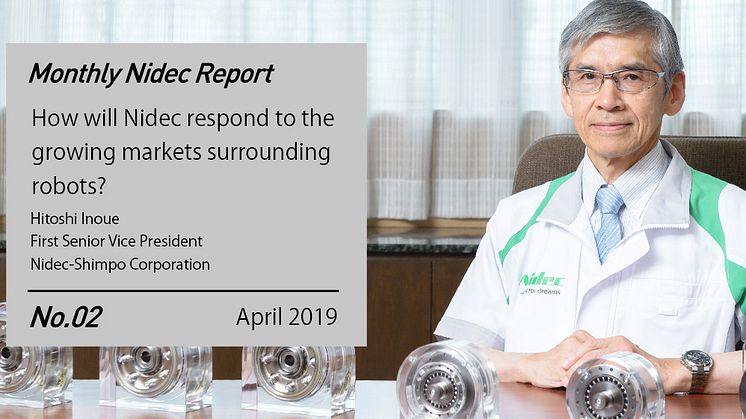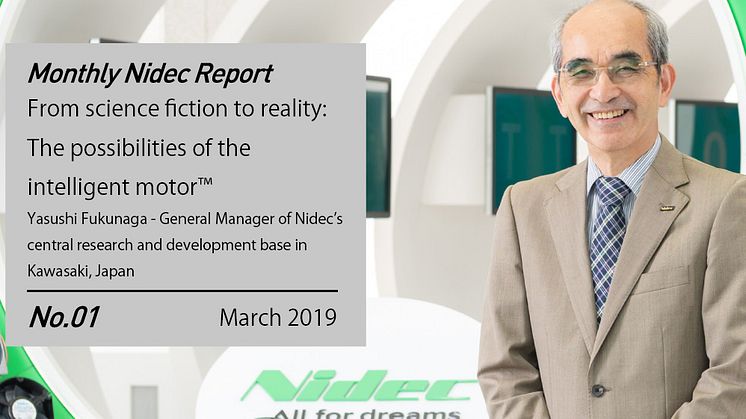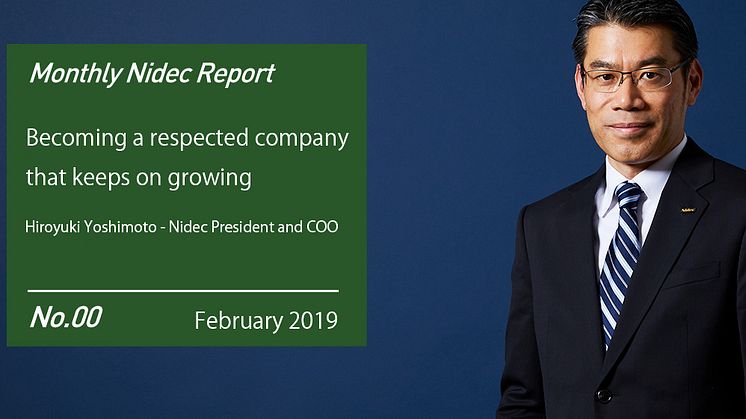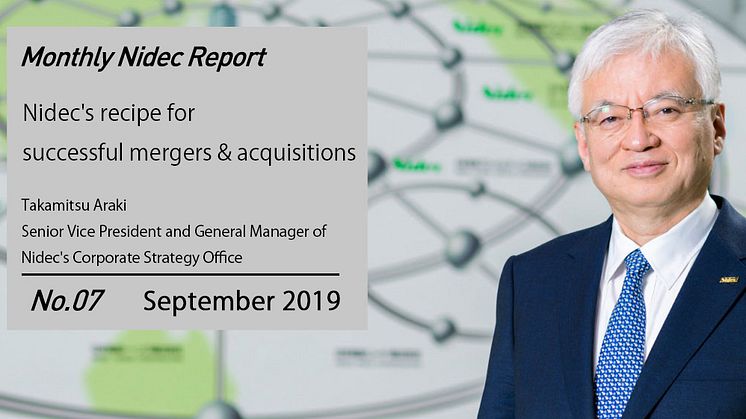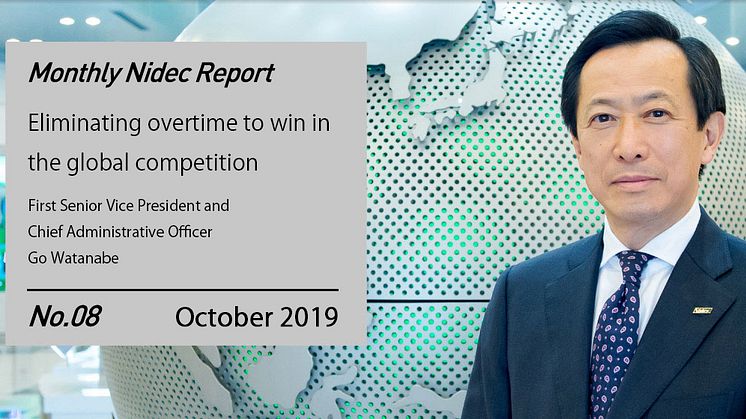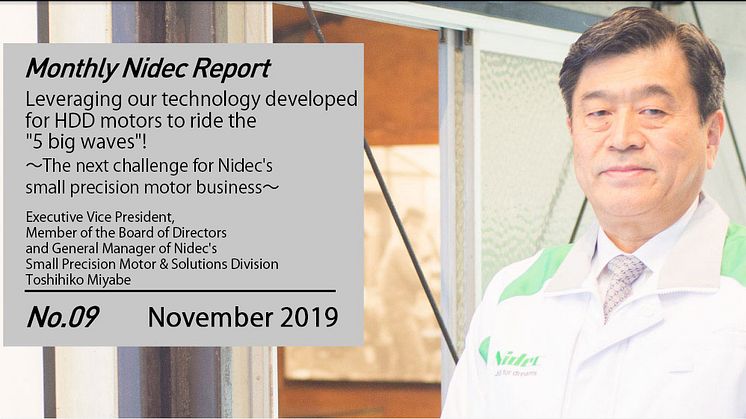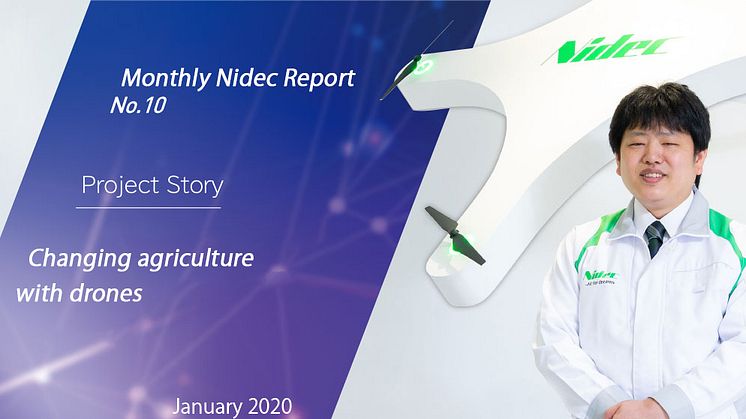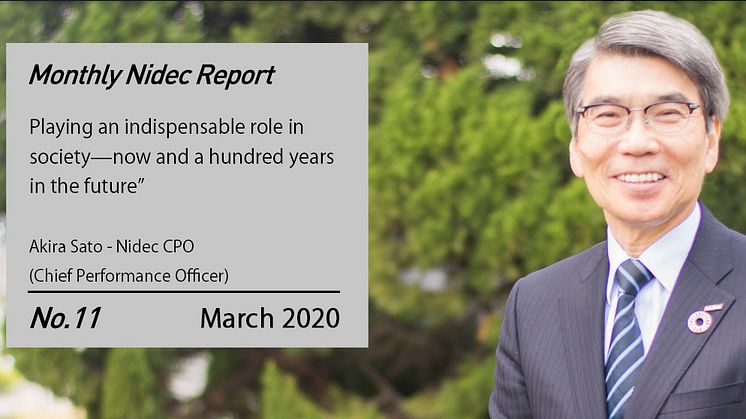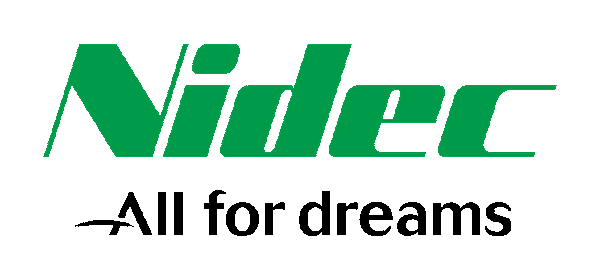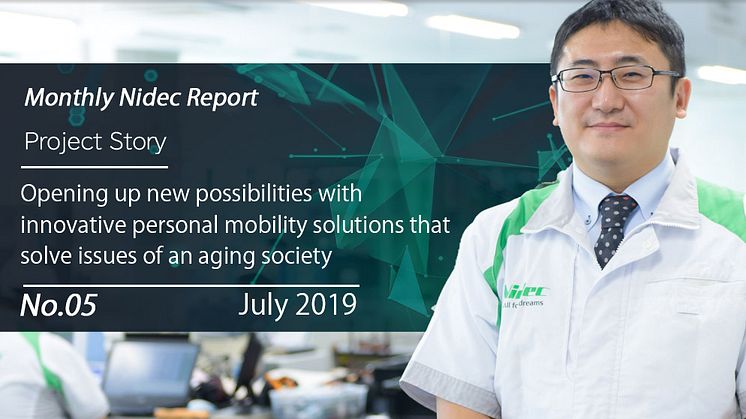
Blog post -
Monthly Nidec Report - Motors for innovative personal mobility solutions
Announced in 2014, the revolutionary power wheelchair "WHILL" stands out for its sophisticated design and ease of use. More than just a wheelchair, it is truly worthy of being called a "next-gen personal mobility device." The latest model, announced in April 2017, is lighter, more compact and even easier to use, in part due to a custom-developed Nidec motor. Currently available in the US and Europe as well, WHILL contributes to improving the quality of life of users around the world who feel a sense of resistance against using conventional wheelchairs.

How did the cooperation between the start-up that develops and sells WHILL and Nidec, the leading global manufacturer of brushless DC motors, start? What were the factors that lead to its success? Follow Kosuke Mizuike, the leader of the motor development project, as he reflects back on these things.
WHILL introduction

WHILL is developed and sold by WHILL Inc., a company founded in 2012 by three young engineers all born in the 80s. It all began with the voice of a single user who did not like being seen as ill and in need of help when using his wheelchair in public: "I've even given up on going to the grocery store just two blocks away." Determined to create a personal mobility device that would overcome psychological barriers as well as physical ones like uneven surfaces and gaps, the founders started WHILL. With an appealing design that entices people to try it out and a light and agile body that enables the device to easily overcome gaps and obstacles, the convention-defying WHILL Model A announced in 2014 was met with surprise and positive reactions around the world.

At the same time, Nidec was searching for new fields and markets. "In particular, we were eyeing the robotics and personal mobility fields. Our expectations were high for the growth of the personal mobility market, as the population, especially here in Japan, is aging rapidly." At the time, Mizuike was involved in the development of a brushless DC motor for electric bicycles. The compact and lightweight motor was capable of instantly producing 300 W of torque."I thought that the motor could be adapted for use in a power wheelchair that requires about the same torque, so we visited WHILL, a company that was receiving a lot of attention for their next-gen personal mobility devices, and pitched the idea of a co-development project based on our motor design.At WHILL, they had just started thinking about the development of an even more compact and lightweight model, their next model after the Model A, and they were in need of a powerful brushless DC motor small enough to fit into the wheel unit.”
Nidec and WHILL—a company in search of new markets and another in search of a compact, lightweight and powerful brushless DC motor. The two companies had found a good match in each other, but there were still some issues left to resolve before development could start.

Nidec has been involved in numerous projects with a wide variety of partners, combining their strengths to create groundbreaking products and solutions, but working with a venture company on a co-development project was a rare occurrence."Nevertheless, I was determined to make the collaboration happen. Of course it was a valuable opportunity to expand upon the motor technology we had nurtured through our development for electric bicycles, but more than anything, I felt a connection with the founders and their passion. I could relate to WHILL’s founders as I was similarly aged to them and I was moved by their mission to 'bring the joy of the outdoors to many people around the world with a new groundbreaking wheelchair.’” The words of the founders—their conviction to 'never settle for a mediocre product'—resonated with, and lit a spark in, Mizuike's own soul and craftsmanship philosophy. "I wanted to work with these people to develop a motor that could help solve issues of an aging society and be useful to people who had qualms about going outside."
Mizuike and his coworkers in development and sales started working out a strategy to gain internal approval of the project.It was imperative that their pitch was convincing and based on a solid foundation of marketing.The demand for WHILL's products was expected to rise as the aging of the population progresses in Japan and other advanced nations; WHILL had financial stability due to the large number of investors who agreed with their ideas and recognized their potential—these were some of the points that Mizuike raised in the internal meeting with his seniors. As a result, the project got the go-ahead; in May 2015 the collaboration between Nidec and newly-founded WHILL was officially greenlit.


The target set by WHILL for their WHILL Model C was to develop a successor to the Model A that only weighed half as much and that could be sold at half the price of its precursor. A compact device that can easily be taken apart and loaded into a car would make it easier for users to take long trips. Of course, a lightweight device requires a small battery though, so the motor would have to be powerful and efficient in addition to being small in order to maximize mileage.
"The motor used by the old model was large and heavy. But by adapting Nidec's compact and powerful brushless DC motor originally developed for electric bicycles, we arrived at a design that was way more compact and lightweight."One of the benefits of brushless DC motors is their long life and durability. Unlike brushed motors that use brushes and commutators to mechanically reverse the current direction in the rotor, electronically commutated brushless DC motors use solid-state circuits to get the job done. As a result, the problem of brushes wearing out is eliminated.
Furthermore, unlike the four-wheel drive Model A, it was decided that the Model C would adopt a rear-wheel-drive design that would make it possible to take the device apart for easy transportation.For this reason, the motors would have to be built into the wheels."Two powerful in-wheel motors, one for each rear wheel, would enable the Model C to overcome obstacles like differently leveled surfaces and make sharp turns just like the Model A.Since Nidec's motor for electric bicycles uses an in-wheel design, it was easy to adapt it for this new application and the development process was sped up quite a bit."
Another thing that helped speed things up was NEDO's (Japan's New Energy and Industrial Technology Development Organization) decision to award a grant to WHILL.


Of course, it wasn't all smooth sailing. "The most difficult part was realizing smooth operation at lower speeds. At first, no matter what we did, we couldn't eliminate the cogging effect that reduced smoothness at low speeds."In order to make the motor spin, we need to use sensors to detect the position of the magnet in the rotor, apply an electric current and send a signal to the electromagnets in the stator.When riding a bicycle, the rotational speed is high enough that the cogging effect doesn't become an issue even though the signals are non-contiguous.However, when the RPM is low, the cogging becomes noticeable."There was a lot of communication back and forth with WHILL and we tested numerous different samples, but we weren't quite able to overcome the problem and satisfy their needs."Smooth operation at low speeds is a condition for being able to stop the device where you want with precision. What's more, small differences in behavior between motors due to cogging could affect the device's ability to stop without shifting to the left or right.

"We will never settle for a mediocre product"—Mizuike could hear the words uttered repeatedly by WHILL's founders since the beginning in his mind."One potential solution was to increase the assembly precision of the motor, but improvements to the manufacturing process would have required vast capital investments, so it wasn't a viable option."Improving the controller seemed to be the only way forward, but this too wasn't an easy task as the controller was developed by WHILL and was outside of the scope of Nidec's role in the project.
It seemed like they had reached a deadlock.But Mizuike and his team had an idea: "Nidec designs controllers too. There should be someone in our company who can help us out." Without delay, they consulted with a senior engineer in a different development team who is knowledgeable about motor controllers. The advice they received was to try solving the issue with a corrective calculation. After the necessary coefficients had been shared with WHILL's development team, they were able to improve the software for the controller and finally the cogging issue was resolved."It makes me happy that we were able to utilize the strength of the Nidec group—that we have access to experts in all kinds of products related to motors through our many development teams."

Eventually, development wrapped up and in April 2017 the motor entered mass-production.Equipped with the motor, the new Model C achieved its development target of half the weight and price of its precursor.The powerful DC motors in the rear wheels allow the Model C to negotiate uneven surfaces with bumps as high as 5 cm. It also has significantly improved usability with a tight turning radius of 76 cm.Additionally, the in-wheel motors are fitted inside the wheel hubs enable more efficient utilization of the space inside the frame and provides more options for placement of the battery and controller.
The WHILL Model C was launched in Europe and the US as well in 2018."From Nidec's perspective, the development time may seem long. But, WHILL has a corporate culture that is very similar to Nidec's in the sense that both companies place a lot of emphasis on speed and doing things right away. I really think that we are on the same wavelength and working together was smooth and easy."
As Nidec's and WHILL's teams visited each other time and time again, measuring the strength of the motor and experimenting with prototypes and more, Mizuike and his coworkers experienced a feeling unlike any other. They were having more fun than they had ever had before during a co-development project."The engineers over at WHILL are all really positive and we had a lot of fun discussing technology and exchanging unusual ideas.Some of their requests were difficult to meet at times, but we could always feel their passion of wanting to create something groundbreaking and we really felt a desire to respond.Acting in accordance with Nidec's motto of 'do it now, do it without fail, do it until it’s completed' and putting our pride on the line contributed to the success of the project in my opinion."


WHILL's mission is to "deliver fun and innovation to pedestrian travel." Moving forward, the aging of the population will progress and at the same time people are expected to live longer in the future. As a result, the number of people who experience difficulties walking long distances for prolonged periods of time is expected to increase as well. Against this background, WHILL paints a picture of a future in which everyone has access to smart mobility that lets them be themselves.
"We at Nidec want to put our technology to use and contribute to realizing this vision painted by WHILL. It would also be great if the know-how that we gained through this project could be adapted for use in other applications like automated guided vehicles for use in factories and large robotic vacuum cleaners for commercial use.”
Motors are unseen. When they reach the end users they are already embedded inside other products."It is rare for us to get an opportunity to hear what the end users think about our products, but in this case WHILL shared with us the feedback of several users who have experienced improvement in quality of life and freedom of movement as a result of this product that uses our motors.It made me happy as I really felt that our technology was helpful.”Technology has the power to improve the lives of people around the world facing different problems." I feel motivated to meet the needs of people waiting for solutions to their problems by developing new technologies that contribute to society on a global scale.”


“The Model C—our second iteration of the WHILL—driven by motors co-developed with Nidec, went on to win various design awards in Japan and overseas and it has also been rated highly for its technology.The version for the US market was honored with the Best of Innovation Award at CES 2018, one of the largest consumer electronics fairs in the world.
“The motors are the most important part of our product. When choosing our partner, we narrowed down our search to Japan-based companies that we can work together with to develop the right motor without compromising on even the smallest details.The reasons why we ended up choosing Nidec is their know-how when it comes to developing compact, lightweight and powerful brushless DC motors, and their global cost competitiveness. In these respects, Nidec really came out on top.We couldn't have hoped for a better partner. Joining hands with Nidec meant that we were able to progress smoothly during development.
“I was really surprised by their speed. The decision-making speed of their management in development matters was really high, and the engineers that we worked with surprised us as well; they would finish writing up the blueprints and technical drawings as we spoke with them in meetings.This sense of speed really made an impression on me and I believe that this is the engine that drives their growth.From here on, the electrification of mobility devices like automobiles and personal mobility will be a major topic.I am sure that Nidec's brushless DC motors will see more and more use in various applications as electrification progresses. As for us, we plan to accelerate our overseas rollout and also branch out into services and systems for non-personal use like shared transportation in train stations, airports, commercial facilities etc. where there may be people who experience difficulties with prolonged walking.With the help of the world's number 1 comprehensive motor manufacturer, we hope to keep on growing and contributing to society.”
